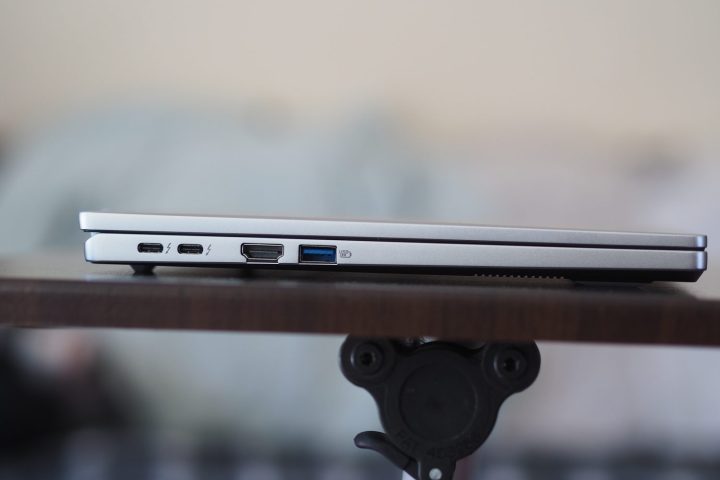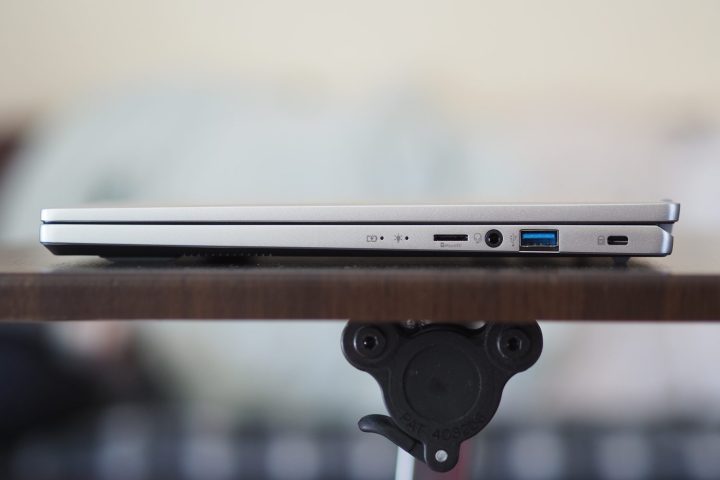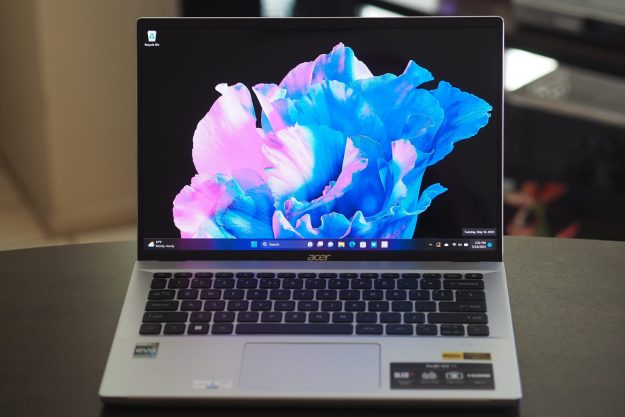
“The Acer Swift Go 14 pairs excellent performance and a beautiful OLED display at a surprising price.”
- Excellent productivity performance
- Bright and colorful OLED display
- Good keyboard
- Solid build
- 1440p webcam
- Display colors were inaccurate on review unit
- Touchpad is a bit small
It’s tempting to unbox yet another 14-inch laptop to review and sigh. Some have stood out, like the Lenovo Yoga 9i Gen 8, while others have relied on attractive pricing and solid performance to compete. The Acer Swift Go 14 falls in the latter category, as it’s a laptop with a high-end CPU and an OLED display offered at a tempting price.
The Swift Go 14 is definitely a value offering. Where the Yoga 9i enjoys a more aesthetically pleasing design and extra standout features for quite a bit more money, the Swift Go 14 focuses on providing excellent performance and an OLED display for an affordable price to help it compete. With one caveat, an issue with the review unit’s color accuracy, I can wholeheartedly recommend the Swift Go 14 for someone on a moderate budget who wants a solid laptop for that money.
Specs and configurations
| Acer Swift Go 14 | |
| Dimensions | 12.32 inches x 8.58 inches x 0.59 inches |
| Weight | 2.76 pounds |
| Processor | Intel Core i7-13700H |
| Graphics | Intel Iris Xe |
| RAM | 16GB LPDDR5 |
| Display | 14.0-inch WQXGA+ (2,880 x 1,800) OLED, 90Hz |
| Storage | 512GB PCIe Gen4 SSD |
| Touch | No |
| Ports | 2 x USB-C with Thunderbolt 4 2 x USB-A 3.2 Gen 1 1 x HDMI 2.1 1 x 3.5mm audio jack 1 x microSD card reader |
| Wireless | Wi-Fi 6E and Bluetooth 5.1 |
| Webcam | QHD (1440p) |
| Operating system | Windows 11 |
| Battery | 65 watt-hours |
| Price | $1,050 |
There are three configurations of the Swift Go 14 currently available. My review unit is priced at $1,050 for a Core i7-13700H, 16GB of RAM, a 512GB SSD, and a 14.0-inch WQXGA+ OLED display. That’s an attractive price for a laptop that promises excellent productivity performance to go with what should be a stunning display. You can drop down to a Core i7-1355U and a Full HD+ (1,92o x 1,200) IPS display for $850, or spend $900 for the same configuration with the Core i7-13700H. All configurations come with 16GB of
A pedestrian design

I’ll be frank here: the Swift Go 14 has a fairly pedestrian design. It’s silverish with simple lines and nothing that makes it stand out. It’s not an unattractive machine — it bears the same kind of minimalist aesthetic that’s quite popular today. You won’t pick the laptop because of its look, but you won’t reject it for that reason, either.
It’s an all-aluminum build that’s quite solid, which I think is to be expected from a laptop that’s $1,000 or more. The lid doesn’t bend unless you exert extreme pressure, and the keyboard deck and bottom chassis are both rigid. It might not live up to Dell XPS or Apple MacBook Pro standards, but then it’s quite a bit less expensive as configured. My biggest complaint is that the hinge is very stiff and you need two hands to open the laptop. That’s a noticeable difference from an XPS or a MacBook Pro.
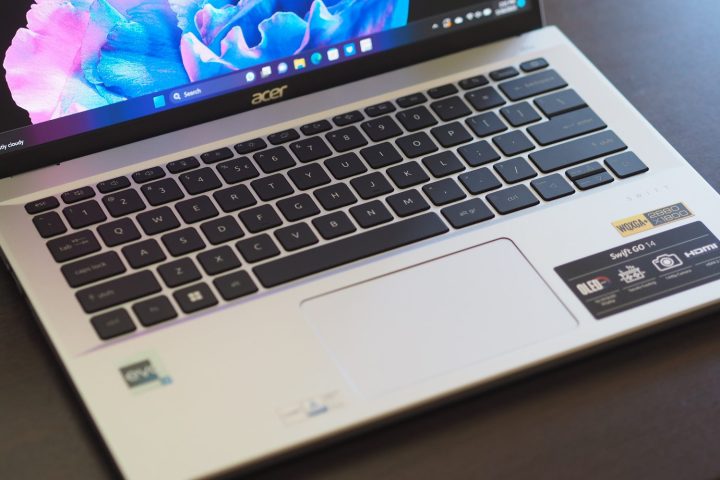
The keyboard has good key spacing and large keycaps, and its switches are light and snappy. They’re a little too light for my tastes, but some people might prefer it that way. It was comfortable for long typing sessions and didn’t slow me down. The touchpad is a little small given the available palm rest space, but it was serviceable. Its clicks were quiet and responsive, so no complaints there. I wish it had a touch display, but that’s not a deal-breaker.
Connectivity is solid, with a Thunderbolt 4 port and good legacy support. Acer kept the audio jack, which is a good thing, and while I prefer a full-size SD card reader, a microSD reader is an OK substitute. Wi-Fi is mostly up to date with Wi-Fi 6E and Bluetooth 5.1.
One standout feature is the webcam, which is a 1440p version — so even better than the emerging 1080p trend. It provided a sharp image with good lowlight handling, making it a good videoconferencing machine. There’s no infrared camera for Windows 11 Hello facial recognition, but the fingerprint reader embedded in the power button worked just fine.
A focus on productivity performance

Performance in creative applications like Adobe’s suite relies on a discrete GPU to help speed various processes. The Swift Go 14 sticks with Intel’s integrated Iris Xe graphics, while equipping a 45-watt Intel Core i7-13700H that provides fast CPU performance. As such, it’s clearly aimed at demanding productivity users — and for them, it excels. Note that for creative apps that don’t leverage the GPU, the Swift Go 14 will provide solid performance.
According to most of our benchmarks, the Swift Go 14 is a fast laptop. The 14-core (six Performance cores at 4.7GHz and eight Efficient cores at 3.5GHz) and 20-thread CPU did well against AMD’s latest, including the Ryzen 7 7735HS, a 35-54 watt, 8-core/16-thread CPU running at up to 4.75GHz. The Acer was a bit slower than the larger Samsung Galaxy Book3 Ultra, but not by a lot. The only benchmark where the Swift Go 14 fell behind is the PCMark 10 complete suite of tests.
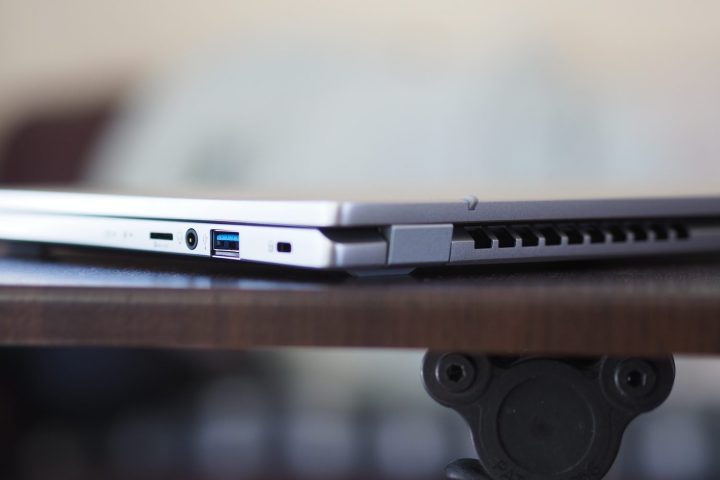
That makes the Swift Go 14 a fast machine for demanding productivity users. Its 3DMark Time Spy test wasn’t anything special, and so it’s no better a gaming laptop than any other Iris Xe machine.
| Geekbench 5 (single / multi) |
Handbrake (seconds) |
Cinebench R23 (single / multi) |
PCMark 10 Complete |
|
| Acer Swift Go 14 (Core i7-13700H) |
Bal: 1,866 / 11,061 Perf: 1,854 / 11,824 |
Bal: 82 Perf: 82 |
Bal: 1,863 / 12,497 Perf: 1,915 / 13,554 |
5,996 |
| Lenovo Slim 7 14 (AMD Ryzen 7 7735HS) |
Bal: 1,493 / 9021 Perf: 1,498 / 9210 |
Bal: 95 Perf: 84 |
Bal: 1,551 / 12,536 Perf: 1,553 / 13,107 |
6,828 |
| HP Dragonfly Pro (AMD Ryzen 7 7736U) |
Bal: 1,473 / 9,061 Perf: N/A |
Bal: 84 Perf: N/A |
Bal: 1,530 / 11,158 Perf: N/A |
6,509 |
| Samsung Galaxy Book3 Ultra (Core i7-13700H) |
Bal: 1,647 / 12,206 Perf: 1,815 / 12,307 |
Bal: 80 Perf: 74 |
Bal: 1,712 / 13,278 Perf: 1,750 / 14,938 |
7,038 |
| Lenovo Yoga 9i Gen 8 (Core i7-1360P) |
Bal: 1,843 / 8,814 Perf: 1,835 / 10,008 |
Bal: 122 Perf: 101 |
Bal: 1,846 / 8,779 Perf: 1,906 / 9,849 |
6,102 |
| Apple MacBook Air M2 (M2) |
Bal: 1,925 / 8,973 Perf: N/A |
Bal: 151 Perf: N/A |
Bal: 1,600 / 7,938 Perf: N/A |
N/A |
The question becomes how much of a penalty are you paying for that faster CPU, especially compared to 28-watt Core i7-1360P machines that feature the more popular chip for thin-and-light
Overall, these results translate to around average battery life that’s not likely to last a full working day. You’ll want to keep your charger nearby.
| Web browsing | Video | PCMark 10 Applications | |
| Acer Swift Go 14 (Core i7-13700H) |
8 hours, 27 minutes | 11 hours, 51 minutes | 9 hours, 57 minutes |
| Lenovo Slim 7 14 (AMD Ryzen 7 7735HS) |
9 hours, 40 minutes | 11 hours, 41 minutes | 10 hours, 34 minutes |
| HP Dragonfly Pro (AMD Ryzen 7 7736U) |
14 hours, 40 minutes | 15 hours, 57 minutes | 16 hours, 31 minutes |
| Lenovo Yoga 9i Gen 8 (Core i7-1360P) |
7 hours, 41 minutes | 13 hours, 25 minutes | 9 hours, 40 minutes |
| Dell XPS 15 9530 (Core i7-13700H) |
9 hours, 43 minutes | 11 hours, 46 minutes | 10 hours, 49 minutes |
| Dell XPS 13 Plus (Core i7-1280P) |
8 hours, 0 minutes | 9 hours, 20 minutes | 6 hours, 52 minutes |
| Apple MacBook Air M2 (Apple M2) |
17 hours, 59 minutes | 21 hours, 9 minutes | N/A |
A slightly problematic display
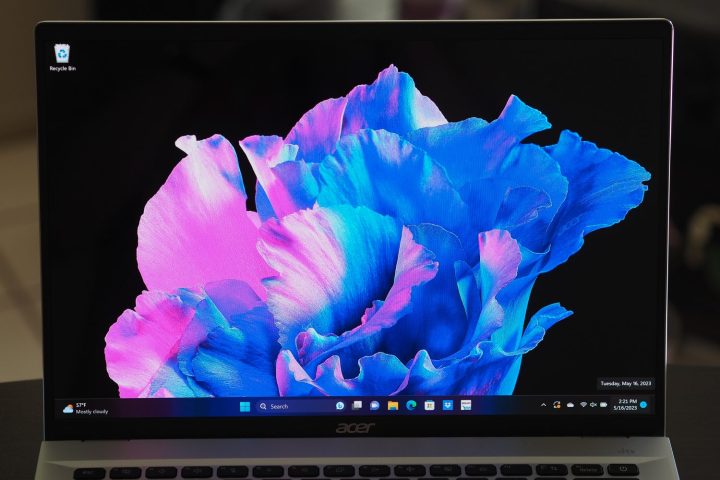
I’d never run across an OLED display that fell outside certain parameters, except for a few where my colorimeter refused to measure the contrast ratio. Most are very close in terms of brightness, color gamut coverage, accuracy, and contrast. The Swift Go 14 did well in most of the tests, with excellent brightness at 523 nits, a wide color gamut at 97% of AdobeRGB and 100% of DCI-P3, and exceptionally high contrast at 36,170:1.
It scored poorly on color accuracy, though, with a DeltaE of 5.96. Every other OLED display we’ve tested has scored close to 1.0 or less, which is where the human eye cannot distinguish a difference. According to Acer, other Swift Go 14 units it has tested scored between 2.1 and 2.5, which is high for an OLED display, but still within an acceptable range. So, it’s likely that my review unit was simply poorly calibrated at the factory.
I wouldn’t dock the display because of this one unit, although again, its color accuracy isn’t as good as other OLED displays I’ve tested. Acer’s Swift Edge OLED scored 1.44 and Swift 3 OLED scored 1.31, so it’s not like Acer is generally selecting panels with less-than-average accuracy for the class. It’s something to think about, but I’m fairly certain this review unit is simply defective.
Audio was fine, with two upward-firing speakers on each side of the keyboard. There was sufficient volume and clarity for casual streaming, but the lack of bass will have you reaching for a pair of
A solid value, as long as you’re willing to risk color accuracy
I went back-and-forth with Acer about the color accuracy I was seeing with the review unit. It’s highly unusual for an OLED display to demonstrate inaccurate colors — in fact, the Swift Go 14 is the first I’ve seen with a DeltaE of over 2.0. But I do believe it’s an issue with the review unit, given that Acer’s testing of other units showed much better results.
That leaves us with a well-priced laptop that’s extremely fast, with very few glaring weaknesses. It’s battery life is a little less than average, but you pay a price for a 45-watt CPU and a power-hungry OLED display. All in all, assuming that my review unit was an outlier, the Swift Go 14 is an easy laptop to recommend.

